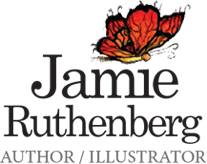Finding What Works For You:
One Author and Illustrator’s Process
By Jamie Ruthenberg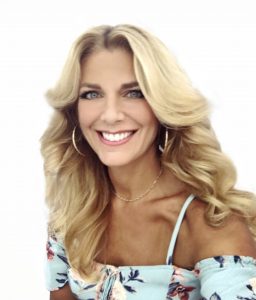
After several years of book signings and special events, I often joke that I know more about other people’s story ideas than I do my own. The discussions I’ve had with most of these wonderful people about how they’ve had their own story ideas in their heads for years almost always end with the one question, a question I have heard more than any other.
“How did you do it?”
In my case, people are especially interested in my own process of writing and illustrating the books I’ve published because I do both the writing and the artwork for the stories. Because of this, both writers and artists alike have continuously approached me, curious about the fine details of how I go about tackling something that seems mysterious. So, I’ve decided to share my own personal process I’ve developed in the hopes that it may be helpful and encourage others to take that first step toward creating their own.
Truthfully, it was more than mysterious to me when I first decided to dive headfirst into the children’s picture book genre. It was downright daunting! The idea of not only creating a story with educational and thematic depth, but also creating all of the illustrations for the story, can be overwhelming (and that’s not to mention the technical formatting of the book, publishing process, etc.). The illustration part of the process was initially the most intimidating because, for one, I am a self-taught artist who never went to art school. Secondly, illustrative work is a special form of art with its own unique process—a process I had yet to discover on my own. However, I realized that I had to take one small step at a time and learn as I go. It was okay to not know everything before starting. Just start.
Truly, it’s all about taking that first step, which in this case is sitting down and actually writing. One helpful habit I have personally developed since I was a young writer is that I don’t wait for the spirit to move me or for some divine, muse-like moment to magically happen. Whether I am full of ideas or the inspirational faucet is clogged, I sit in front of my computer and try to write something. Anything. It’s not always pretty, but if I sit there long enough, eventually good things begin to flow.
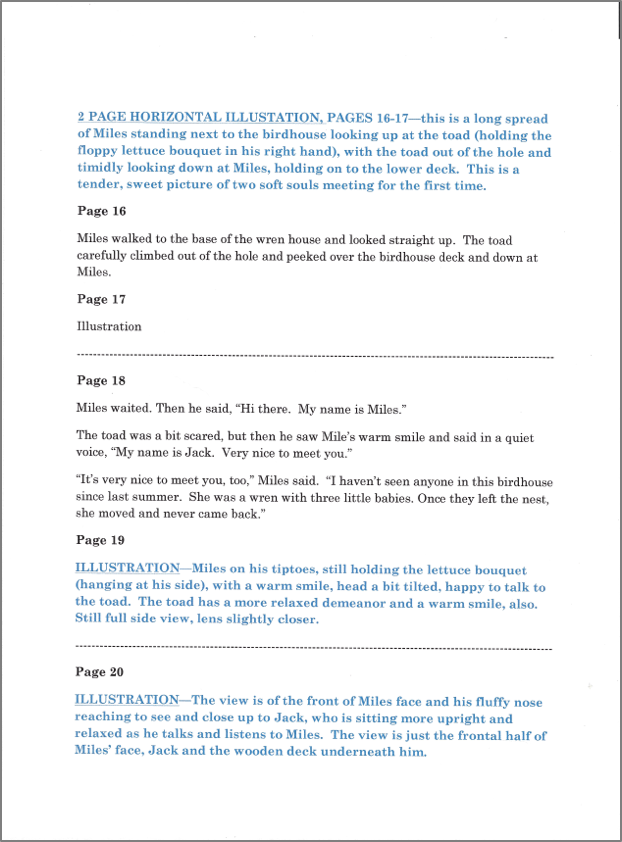
Manuscript pages 16-20 from Miles and the Wren House Toad
Specifically, with the Miles Series, I begin with writing the manuscript in a format that works for me. I organize the writing by the numbered, physical pages of the book, just like a publisher or book printer would view the book files (which doesn’t include any physical part of the cover). For each numbered page, I write the text for that specific page, and I also describe in writing what the artwork will look like for that two-page spread in a different colored font. In the children’s picture book genre, illustrations tell half of the story, so it is incredibly important to understand what exactly the artwork will be as the story is developing.
Once the first draft of the manuscript is completed, I then make what I call a prototype of the book—my own version of a crash test dummy—by folding many layers of printing paper together and cutting the “book” down to a smaller version of the final product. It is then that I map out, page by page, where the typesetting (printed text) will be as apposed to where the artwork will be for each two page spread. This is a quick, very rough (and I mean very rough!) sketching of what I will eventually draw and paint, and it’s a critical step before actually creating the artwork. Ultimately, the composition of the art has to be in harmony with where the printed story will be. Both have to work together to create an aesthetic visual.
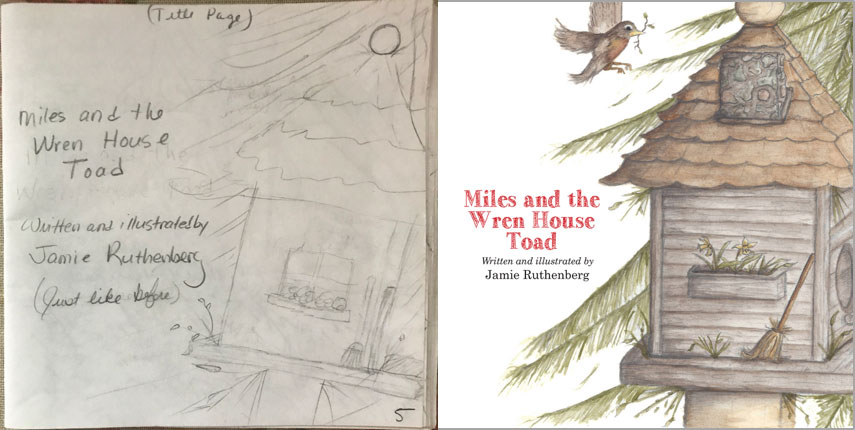
Before and after. Mapping out a quick prototype sketch of the title page for Miles and the Wren House Toad
Now I can start drawing! Before painting with watercolor paint, all of the pieces of artwork are drawn on pre-cut, smooth illustration board. The art phase of the process has evolved for me personally. Through experience, I have realized that it is smart to draw all of the pieces first before my paintbrush touches anything. Why? It leaves room for revision. Yes, I not only revise the manuscript throughout the process; I also revise the artwork. If something is revised in the manuscript, it often has to be changed in the artwork, as well, and a visa versa. When it comes to this process, my eraser is definitely my best friend!
Once I am certain that the story and the illustrations are as they should be, I begin to paint. I personally love the softness and flow of watercolor paint, and it never gets old to finally see the artwork come to life with color.
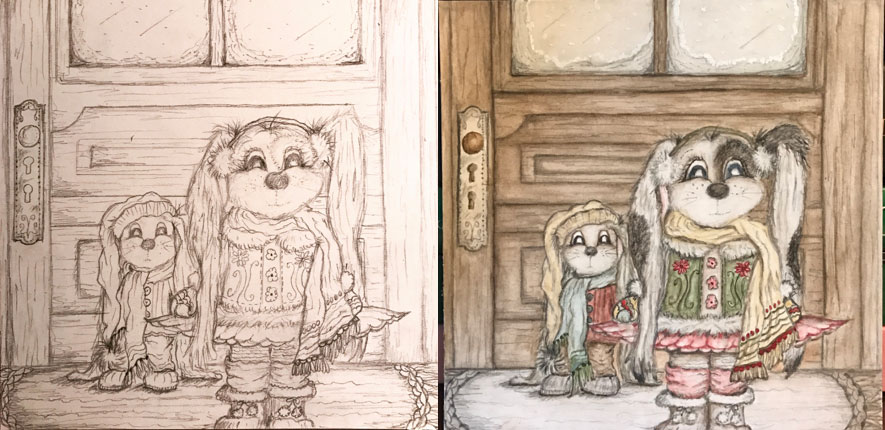
Violet and Gabriel, page 15 in Miles and the Best Birthday Gift
When all the artwork is completed, it’s time to piece everything together and make a book! For the Miles Series, I have been lucky enough to work with a wonderful graphic designer who has helped me grow so much in my knowledge of technical formatting. The process is a heavy mix of the technical and aesthetic, with too many details to include here—this topic could easily be its own blog!
However, the goal of this part of the process is to create two PDF files of the interior and cover of the book through the use of book design software. Once the files are completed, it’s time for me to make sure everything is where it should be, and to once again do a thorough editing of the typesetting. There are almost always little tweaks and alterations that happen, which entails lots of emails and conversations, but in the end, it is all worth it. I always feel the excitement of a child when looking at the final reader spreads of what I envisioned months and months ago when I first sat down to write. At this point, the book is finally real!
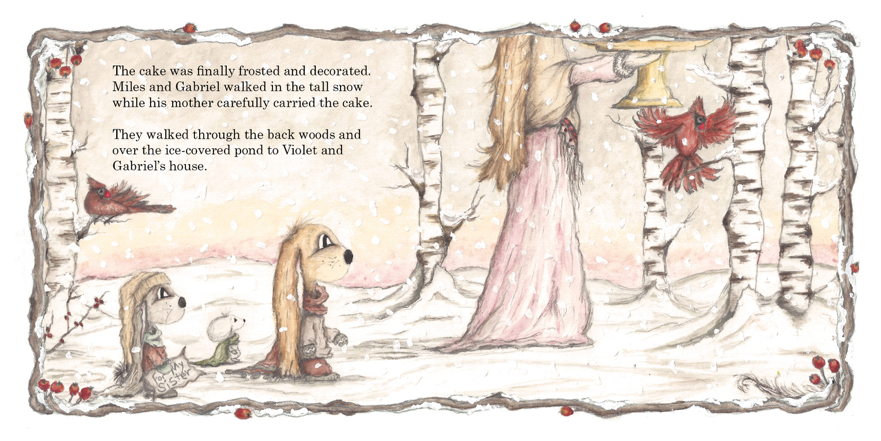
Miles, his mother, and Gabriel walking through the snow to Violet’s birthday party.
Page 32-33 in Miles and the Best Birthday Gift
The only feeling better in this process than this moment is the moment the first physical prototype of the book comes in the mail for review before printing. My heart always beats out of my chest when I hear the knock at the door when it is delivered. There is nothing like opening the package and holding that book in my hands for the first time!
I brought this series to life through self-publishing and currently use a self-publishing arm of Amazon’s, but there are many avenues through which to travel for publishing. It all depends on what opportunities you may have or what you want to achieve. For myself, I have had the creative freedom to make this series exactly what I want it to be though self-publishing. The Miles Series is not completed; there will be at least five books in the series. However, at this point, I would love to sign on with a publisher. Nonetheless, being free to create and learn what I did throughout this process allowed me to have one of the most invaluable experiences of my life.
Of course, because of the involved nature of the process, I couldn’t include every detail, but I hope what I just described helps, if even just one person. However, all details aside, I believe doing something like this is really about two things.
The first thing is this—the nature of the venture involves vulnerability. You have to be willing to put a large piece of yourself “out there” at the risk of not being well received, which is a scary thought for many. However, it’s not about being fearless. It’s about being brave and doing something in the face of fear.
Second, it’s about sitting down and forcing yourself to actually do it, anything at first. What you initially create doesn’t even have to resemble the end result. You just have to keep trying until something feels right, and never give up until it does.
JR
